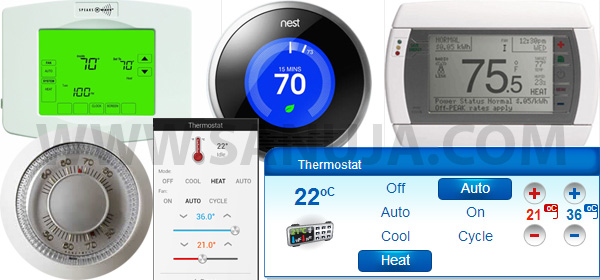In most parts of the developed world, we live in houses that are at least ten years old (or often older). Hence homeowners spent their money on home improvements. One of the easiest ways to renovate your house is to replace the old units with new ones. Today I am going to discuss a simple item found in every Canadian household; the thermostat.
Good old days
Thermostats in the past are based on mercury switches. The temperature and humidity information is passed to the furnace, air conditioner, and humidifier from a mechanical leaver inside the thermostat. Today, the same task can be done either electronically or electrically without the use of mercury or mechanical parts. Almost all modern thermostats operate by sending electrical signals via two circuits built in to the controller and the receiver on the other end.
Choices
With electronic controllers, you can buy thermostats from several different manufactures. Additionally, there are many models even from the same manufacture. This is expected because modern units are not limited to manual controls. Depending on the type of the unit, you may be able to control the temperature and other aspects either remotely or via an automated system.
When purchasing a unit, here are few pointers to think about;
How old is your current furnace/heater, air conditioner and humidifier?
What are the types of input controls in your current units (can it take an electronic signal)?
If your units are old enough to replace, it may be time to replace them with modern cutting-edge units. This way you can use any thermostat to control them. If you have an older unit, then make sure you have the right configuration for whichever the thermostat you want to install. For example, if you are missing a specific wire required for an electronic automated thermostat, you may either have to add an additional circuit box in between the controller and the heating/cooling unit or you may have to opt-in for a traditional older thermostat. This is where the return policy of the store will help you out! However, you can avoid returning an item by doing your research before you buy one.
Technology
There are several technologies in the consumer market. Most of them are proprietary technologies made by companies like Nest and Honeywell. Others have little more flexibility with built-in standards like Z-wave, which can be used along with any Z-wave controller.
Most “smart” thermostats can be connected to your LAN (home network) and ultimately to the Internet. You can control these thermostats from computers and mobile devices in addition to physical controls. You can create accounts and enforce restrictions on who can control what. You can create schedules or in some thermostats can learn from your behavior and automatically create schedules for you (eg. Nest). You can create relationships between the thermostat and other units in the house. For example, you can connect a Z-wave thermostat to your front door sensor. Then you can set it up so that if the front door is opened between 4-6 PM, the temperature will increase from 19 C to 21 C. This way when you come back from work, the house will be warmed up in few minutes. With the electronic and Internet age, the possibilities to make your house a home with technology are endless.
So when you are ready to buy a thermostat, ask yourself what do you want to do with it. Do you simply want to control the temperature? Or do you want to control the temperature via a computer in the house or mobile device or anywhere in the world? Of course, how much will you be spending?
Proprietary or Independent
Personally, I prefer flexible options because it limits dependencies. If you have a Nest thermostat, for your remote controls you will depend on the Nest network. Any issues there including technical or otherwise (like free to paid service), must go through Nest company. Contrast this with a Z-wave unit like Honeywell VisionPro Thermostat, in which the remote control is done through your home LAN and Internet connection. To me, it is no brainier; Z-wave is better for independence.
Here are some key things about proprietary versus the Z-wave based thermostats (or any other equipment). With proprietary technologies, you get much better security and reliability. Since millions of others also use the same network and technology, you will provide cutting edge support for your thermostat. It is also easier to set up a Nest thermostat than to set up a Z-wave thermostat for most people. However, you will be giving up your personal information such as “Away from home time/temperature” to a server somewhere in the world. Since you are one of the millions of others on the same network, you may be vulnerable to cybersecurity issues. Additionally, you have no control over the network itself. While it may be reliable and secure, if the company responsible for the network decided to charge you for the remote service, you have no choice but to pay (or stop using the remote features).
Installation
Installation is very simple assuming you have all the right wires. In other words, as long as you have a compatible heating/cooling unit, you can install the thermostat by yourself. I found the programming the thermostat is harder than the actual installation process. But it is just me!

